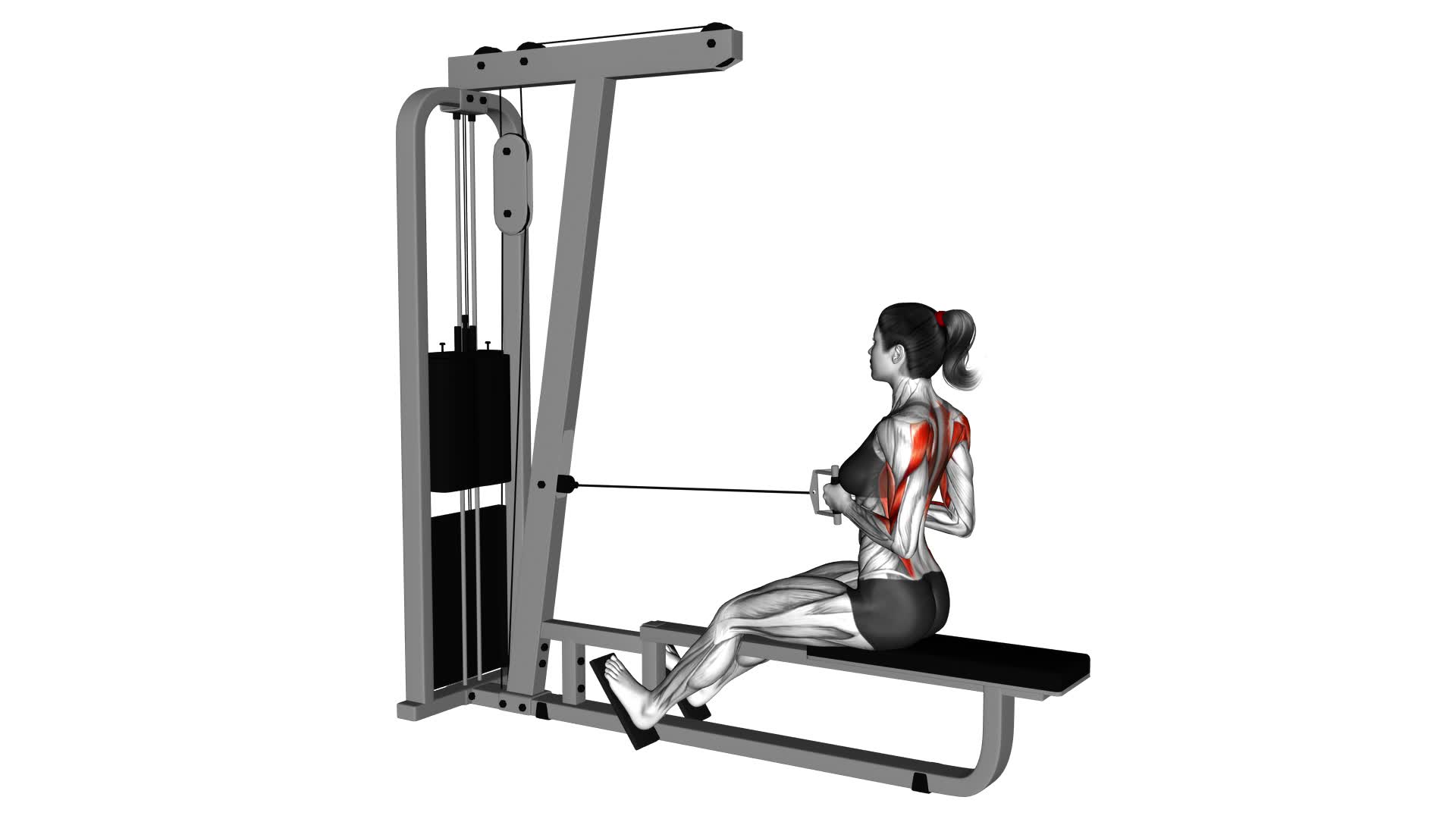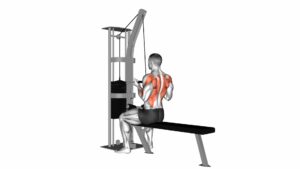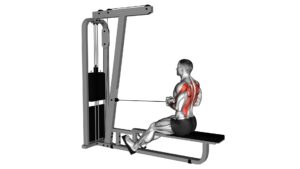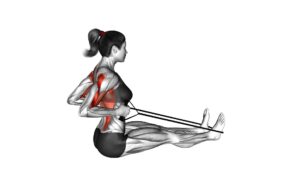Cable Straight Back Seated Row (female) – Video Exercise Guide & Tips

Are you looking to strengthen your back and improve your posture? The Cable Straight Back Seated Row is the perfect exercise for you.
Watch This Exercise Video
In this video exercise guide, we will walk you through the proper technique and form specifically for females. Learn about variations and modifications to suit different fitness levels, common mistakes to avoid, and tips for maximizing results and preventing injury.
Get ready to take your workout to the next level with this effective exercise.
Key Takeaways
- The Cable Straight Back Seated Row is beneficial for improving posture and increasing back strength.
- It helps reduce the risk of rounded shoulders and a hunched back.
- This exercise targets upper back muscles such as rhomboids, trapezius, and rear deltoids.
- It alleviates tension and strain on the neck, shoulders, and lower back while enhancing breathing and digestion.
Benefits of the Cable Straight Back Seated Row
Discover the benefits you can experience from the Cable Straight Back Seated Row. This exercise is highly effective in improving posture and increasing back strength. By incorporating this exercise into your workout routine, you can achieve a straighter and more aligned posture, reducing the risk of common postural issues such as rounded shoulders and a hunched back.
The Cable Straight Back Seated Row specifically targets the muscles in your upper back, including the rhomboids, trapezius, and rear deltoids. As you perform the exercise, you'll feel these muscles working to retract your shoulder blades, promoting a more upright position. Strengthening these muscles not only enhances your posture but also contributes to better overall back strength.
Having improved posture provides numerous benefits beyond just looking better. It can alleviate tension and strain on your neck, shoulders, and lower back, reducing the likelihood of developing chronic pain or injuries in these areas. Additionally, proper posture can enhance breathing and digestion, as it allows your organs to function optimally.
Proper Technique and Form for Females
To achieve optimal results with the Cable Straight Back Seated Row, females should focus on mastering the proper technique and form. Proper form ensures that the targeted muscles are effectively engaged while minimizing the risk of injury. When performing this exercise, it's crucial to maintain a straight back and keep your shoulders relaxed. Avoid rounding your back or hunching your shoulders, as this can place unnecessary strain on your spine and reduce the effectiveness of the exercise.
To begin, sit on the machine with your feet firmly planted on the footrests. Grasp the handles with an overhand grip, ensuring that your hands are shoulder-width apart. Slowly pull the handles towards your midsection, squeezing your shoulder blades together as you do so. Keep your elbows close to your body and your wrists straight throughout the movement. As you reach the fully contracted position, pause for a moment before slowly returning to the starting position.
By maintaining proper form, you'll maximize muscle activation in the targeted areas, such as the upper back, shoulders, and biceps. It's important to note that the weight used should be challenging but manageable, allowing for controlled and smooth movements. Remember to breathe steadily throughout the exercise, inhaling as you pull the handles and exhaling as you return to the starting position.
Variations and Modifications for Different Fitness Levels
Now that you have learned the proper technique and form for the cable straight back seated row, it's time to explore the variations and modifications available for different fitness levels.
Whether you're a beginner looking for beginner-friendly modifications or an advanced exerciser seeking advanced level variations, there are options to suit your needs.
These modifications and variations will help you progress in your fitness journey and challenge your body in new ways.
Beginner-Friendly Modifications
For beginners, try modifying the cable straight back seated row exercise to suit your fitness level. Here are some modification options and safety precautions to consider:
- Reduce the weight: Start with a lighter weight to build strength and avoid straining your muscles.
- Decrease the resistance: Adjust the cable machine to a lower setting to make the exercise less challenging.
- Use an underhand grip: Instead of an overhand grip, try using an underhand grip to engage different muscles in your back.
- Focus on proper form: Pay attention to your posture and technique, keeping your back straight and shoulders relaxed throughout the exercise.
By making these modifications and following safety precautions, you can gradually increase the intensity of the cable straight back seated row exercise as you progress.
Now, let's move on to advanced level variations to further challenge yourself.
Advanced Level Variations
To challenge yourself at an advanced level, try incorporating these variations and modifications into your cable straight back seated row exercise.
For advanced modifications, you can increase the weight on the cable machine to further challenge your back muscles. This will require more strength and stability to perform the exercise effectively.
Another advanced technique tip is to add a pause at the peak of the movement. When you pull the cable towards your body, hold it for a second or two before slowly releasing it back to the starting position. This will increase the time under tension and intensify the workout.
Additionally, you can try performing the exercise with one arm at a time, alternating between sides. This unilateral movement will engage your core and improve balance.
Remember to maintain proper form and control throughout the exercise, even at an advanced level.
Common Mistakes to Avoid
Avoiding these common mistakes will help you perform the Cable Straight Back Seated Row exercise effectively. Here are some mistakes to avoid for injury prevention:
- Using too much weight: One common mistake is using a weight that's too heavy for your strength level. This can lead to improper form and put unnecessary strain on your muscles and joints. Start with a lighter weight and gradually increase as you become more comfortable and confident with the exercise.
- Rounding your back: It's important to maintain a straight back throughout the exercise. Rounding your back not only reduces the effectiveness of the exercise but also puts you at risk of injury. Keep your chest up, shoulders back, and engage your core to maintain proper form.
- Pulling with your arms: The cable straight back seated row is primarily a back exercise, so it's important to focus on engaging your back muscles rather than relying on your arms to do the work. Pull the cable towards your midsection by squeezing your shoulder blades together and engaging your back muscles.
- Rushing the movement: Performing the exercise too quickly can lead to poor form and increase the risk of injury. Take your time and focus on the quality of each repetition. Control the movement on the way up and down, and make sure to fully extend your arms and squeeze your shoulder blades together at the top of the movement.
Tips for Maximizing Results and Avoiding Injury
To maximize your results and avoid injury, focus on proper form and technique while performing the Cable Straight Back Seated Row exercise. Injury prevention should always be a top priority in any workout routine. When performing this exercise, it's important to maintain a neutral spine and engage your core muscles. This will help protect your lower back and prevent any strain or injury. Additionally, make sure to keep your shoulders relaxed and down, avoiding any shrugging or tension in the neck area.
Muscle activation is another key aspect to consider. To fully engage your back muscles during the Cable Straight Back Seated Row, focus on squeezing your shoulder blades together at the end of each repetition. This will help target the muscles in your upper back, specifically the rhomboids and trapezius.
Remember to start with a weight that challenges you but still allows you to maintain proper form. Gradually increase the weight as your strength improves. It's better to perform the exercise correctly with lighter weights than to use heavier weights and sacrifice form.
Sample Workout Routine Incorporating the Cable Straight Back Seated Row
Start your sample workout routine by incorporating the Cable Straight Back Seated Row exercise. This exercise is an excellent way to target your back muscles and improve your overall strength and posture.
To maximize the effectiveness of your workout and prevent injuries, consider the following modifications and injury prevention tips:
- Warm up: Before starting your workout, warm up your muscles with some light cardio exercises such as jogging or jumping jacks. This will increase blood flow to your muscles and prepare them for the upcoming workout.
- Proper form: When performing the Cable Straight Back Seated Row, make sure to sit up straight and keep your back flat against the seat. Avoid rounding your shoulders or hunching forward, as this can put unnecessary strain on your back and increase the risk of injury.
- Gradually increase weight: Start with a lighter weight and gradually increase the resistance as you become stronger and more comfortable with the exercise. This will help you avoid overloading your muscles and reduce the risk of strains or muscle imbalances.
- Rest and recovery: Allow your muscles time to rest and recover between workouts. This will help prevent overuse injuries and allow your muscles to grow and adapt to the demands of the exercise.
Incorporating the Cable Straight Back Seated Row into your workout routine can help you improve your back strength and posture. By following these workout modifications and injury prevention tips, you can ensure a safe and effective workout.
Frequently Asked Questions
How Many Sets and Repetitions Should I Do for the Cable Straight Back Seated Row Exercise?
To determine the optimal weight and resistance for the cable straight back seated row exercise, it's important to consider your fitness level and goals. Start with a weight that challenges you, but allows you to maintain proper form throughout the exercise.
Aim for 3-4 sets of 8-12 repetitions, resting for 30-60 seconds between sets.
Common mistakes to avoid include using momentum instead of controlled movements, rounding your back, and pulling with your arms instead of engaging your back muscles.
Can I Perform the Cable Straight Back Seated Row Exercise if I Have Lower Back Pain?
If you're experiencing lower back pain, it's important to be cautious when performing the cable straight back seated row exercise. Instead, consider alternative exercises that target the same muscle groups without putting strain on your lower back.
There are various options such as bent over rows, dumbbell rows, or seated cable rows with a chest support. These alternatives can help prevent further discomfort and provide a safer workout experience.
Always listen to your body and consult a professional if you have any concerns.
Is It Better to Use a Wide Grip or Narrow Grip for the Cable Straight Back Seated Row Exercise?
When deciding on a grip width for the cable straight back seated row, it's important to consider the benefits of different options.
A wide grip targets your upper back and rear deltoids more intensely, while a narrow grip places more emphasis on your biceps and middle back.
Both grips have their advantages, so it ultimately depends on your goals and personal preference.
Experiment with both to find what feels most effective and comfortable for you.
Can I Replace the Cable Straight Back Seated Row Exercise With a Similar Exercise That Targets the Same Muscles?
Sure, you can definitely find alternative exercises that target the same muscles as the cable straight back seated row.
There are various variations of the seated row exercise that you can try, such as using different equipment like dumbbells or resistance bands.
Additionally, you can also incorporate different grips, like a wide grip or narrow grip, to change the emphasis on different muscles.
Experimenting with these variations will help you find what works best for you.
Are There Any Specific Warm-Up Exercises That I Should Do Before Performing the Cable Straight Back Seated Row Exercise?
Before performing the cable straight back seated row exercise, it's important to do some specific warm-up exercises. These exercises will help prepare your muscles and joints for the workout ahead.
Warm-up exercises for cable row can include arm circles, shoulder rolls, and light cardio activities like jumping jacks or jogging in place. Incorporating these warm-up exercises into your routine can help prevent injury and ensure that you get the most out of your cable row workout.
Additionally, cable row exercises are great for building upper body strength and targeting muscles in the back, shoulders, and arms.
Conclusion
Incorporating the cable straight back seated row into your workout routine can provide numerous benefits for females. By using proper technique and form, you can effectively target your back muscles and improve strength and posture.
It's important to avoid common mistakes and follow tips for maximizing results and avoiding injury. By including this exercise in a well-rounded workout routine, you can achieve optimal results and improve your overall fitness level.

Author
Years ago, the spark of my life’s passion ignited in my mind the moment I stepped into the local gym for the first time. The inaugural bead of perspiration, the initial endeavor, the very first surge of endorphins, and a sense of pride that washed over me post-workout marked the beginning of my deep-seated interest in strength sports, fitness, and sports nutrition. This very curiosity blossomed rapidly into a profound fascination, propelling me to earn a Master’s degree in Physical Education from the Academy of Physical Education in Krakow, followed by a Sports Manager diploma from the Jagiellonian University. My journey of growth led me to gain more specialized qualifications, such as being a certified personal trainer with a focus on sports dietetics, a lifeguard, and an instructor for wellness and corrective gymnastics. Theoretical knowledge paired seamlessly with practical experience, reinforcing my belief that the transformation of individuals under my guidance was also a reflection of my personal growth. This belief holds true even today. Each day, I strive to push the boundaries and explore new realms. These realms gently elevate me to greater heights. The unique combination of passion for my field and the continuous quest for growth fuels my drive to break new ground.







